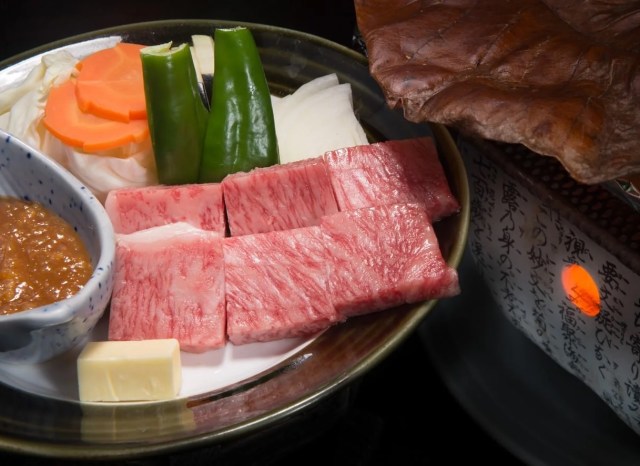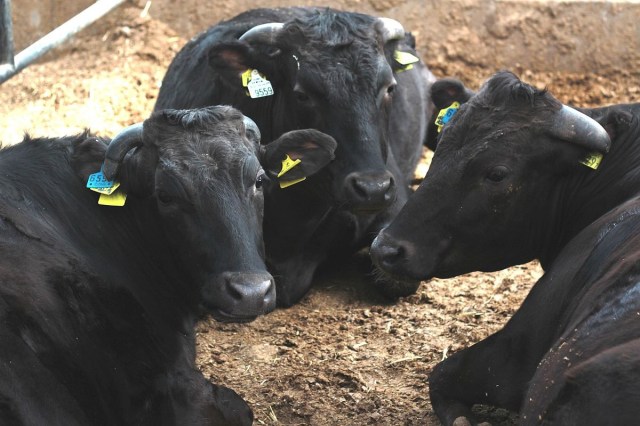
Before you order that Japanese steak, make sure you know what you’re getting.
Along with sushi and ramen, Japanese beef is on the short list of foods gourmands look forward to eating on a trip to Japan. While it often carries a hefty premium over other kinds of meat, true believers insist that Japanese beef is well worth the extra cost due to how tender and flavorful it is.
But it turns out there’re two Japanese terms that can be translated as “Japanese beef,” but which actually have different meanings. So what’s the difference? Let’s take a look.
1. Wagyu / 和牛
The term that’s most likely to pop up in English discussions and menus is wagyu, with wa meaning “Japan” and gyu meaning “beef.” But being a cow in Japan doesn’t necessarily qualify the animal for wagyu status. To earn the label, the cow has to be one of four traditional Japanese breeds: Kuroge (“Black Hide”) Wagyu, Akage (“Red Hide”) Wagyu, Nihon Tankakushi (Japanese Shorthorn), or Mukakuwashu (Japanese Polled Cattle).
Japan’s most famous beef varieties, Kobe and Matsuzaka, are subsets of Tajima cattle, itself a strain of Kuroge Wagyu, and so can be called wagyu.
▼ Kuroge Wagyu
However, it’s possible for meat sourced from outside Japan to also be called wagyu, so long as the cows are one of the four types mentioned. While such situations are rare, there are wagyu ranches in both Australia and the U.S.
2. Kokusangyu / 国産牛
But if wagyu can be called “Japanese beef,” so too can kokusangyu, literally “beef produced in the country (i.e. Japan).” Kokusangyu refers to any domestically raised cow, regardless of whether or not it falls into one of the four wagyu breeds. Holsteins raised in Japan, for example, are kokusangyu, but not wagyu. So, for example, beef from Holsteins raised in Japan wouldn’t be classified as wagyu, but it would be classified as kokusangyu.
Technically, this means that any Japan-raised wagyu is also kokusangyu. There’s a small loophole though, in that cows born in another country which are then relocated and spend the majority of their lives in Japan can also be called kokusangyu.
So, in summary, wagyu gives you a clue to the breed, and kokusangyu indicates where the animal was raised. Since wagyu is widely held to be high-quality meat, and Japan always has a preference for domestically produced foodstuffs, both wagyu and kokusangyu carry plenty of cachet. Generally, though, wagyu gets more mouths watering and wallets opening, since imported wagyu is almost never seen in Japan.
With this in mind, if you’re after the most prestigious beef Japan has to offer, you might want to take the boasting of restaurants trumpeting their kokusangyu with a grain of salt, as the type of beef itself might be the same as what you can get in your own country. So before you get drawn into a restaurant by the tempting promise of “Japanese beef,” you might want to check just what kind of Japanese beef it is.
Follow Casey on Twitter, where he tweets between meals of delicious hamburger steak.
Sources: Consumer Affairs Agency, Tanaka Seinikuten, Mojisho
Top image: Pakutaso
Insert images: Wikipedia/Phoenix7777
[ Read in Japanese ]


 Eat Kuroge Wagyu beef at this Japanese restaurant in Ginza for less than 10 bucks!
Eat Kuroge Wagyu beef at this Japanese restaurant in Ginza for less than 10 bucks! Japanese Black Wagyu from Yoshinoya – Premium beef isn’t just for politicians anymore!【Taste test】
Japanese Black Wagyu from Yoshinoya – Premium beef isn’t just for politicians anymore!【Taste test】 Strawberry and beef? We try Lotteria’s new Tochigi Wagyu Steak Hamburger with Strawberry Sauce
Strawberry and beef? We try Lotteria’s new Tochigi Wagyu Steak Hamburger with Strawberry Sauce Wagyu Burger opens in Tokyo, serving up highest-grade beef at reasonable prices
Wagyu Burger opens in Tokyo, serving up highest-grade beef at reasonable prices Yoshinoya’s wagyu beef box for Japanese politicians
Yoshinoya’s wagyu beef box for Japanese politicians New Nintendo Lego kit is a beautiful piece of moving pixel art of Mario and Yoshi【Photos】
New Nintendo Lego kit is a beautiful piece of moving pixel art of Mario and Yoshi【Photos】 How to order snacks on a Shinkansen bullet train in Japan
How to order snacks on a Shinkansen bullet train in Japan Hello, cosmetics! Clinique teams up with Hello Kitty this summer for first-time collaboration
Hello, cosmetics! Clinique teams up with Hello Kitty this summer for first-time collaboration Demon Slayer: Kimetsu no Yaiba gets new roller coaster attractions and food at Universal Studios Japan
Demon Slayer: Kimetsu no Yaiba gets new roller coaster attractions and food at Universal Studios Japan McDonald’s adds new watermelon frappe and fruity macaron to its menu in Japan
McDonald’s adds new watermelon frappe and fruity macaron to its menu in Japan Cosmetic wizardry: Asian women removing makeup to reveal their true selves goes viral【Video】
Cosmetic wizardry: Asian women removing makeup to reveal their true selves goes viral【Video】 Tsukiji Fish Market Vendor Releases Tuna For Home Assembly
Tsukiji Fish Market Vendor Releases Tuna For Home Assembly High-fashion Totoro cuddle purse is like an elegant stroll in the forest【Photos】
High-fashion Totoro cuddle purse is like an elegant stroll in the forest【Photos】 U.S. Olympic athlete reveals he runs with Yi-Gi-Oh! cards tucked into his uniform【Video】
U.S. Olympic athlete reveals he runs with Yi-Gi-Oh! cards tucked into his uniform【Video】 Japan’s new difficult-to-drink-from beer glass protects your liver, but it’s a brutal experience
Japan’s new difficult-to-drink-from beer glass protects your liver, but it’s a brutal experience Nintendo history you can feel – Super NES, N64, and GameCube controllers become capsule toys
Nintendo history you can feel – Super NES, N64, and GameCube controllers become capsule toys “The most Delicious Cup Noodle in history” – Japan’s French Cup Noodle wins our heart【Taste test】
“The most Delicious Cup Noodle in history” – Japan’s French Cup Noodle wins our heart【Taste test】 Starbucks releases a cute Frappuccino and Unicorn Cake…but not in Japan
Starbucks releases a cute Frappuccino and Unicorn Cake…but not in Japan Kyoto Tower mascot termination reveals dark side behind cute Japanese characters
Kyoto Tower mascot termination reveals dark side behind cute Japanese characters McDonald’s Japan’s Soft Twist Tower: A phantom ice cream only sold at select branches
McDonald’s Japan’s Soft Twist Tower: A phantom ice cream only sold at select branches Yabai Ramen: What makes this Japanese ramen so dangerous?
Yabai Ramen: What makes this Japanese ramen so dangerous? Finally! Nintendo Japan expands Switch 8-bit controller sales to everybody, Online member or not
Finally! Nintendo Japan expands Switch 8-bit controller sales to everybody, Online member or not Japanese government wants to build luxury resorts in all national parks for foreign tourists
Japanese government wants to build luxury resorts in all national parks for foreign tourists To combat declining birth rate, Japan to begin offering “Breeding Visas” to foreigners
To combat declining birth rate, Japan to begin offering “Breeding Visas” to foreigners 10 things you should buy at 7-Eleven in Japan
10 things you should buy at 7-Eleven in Japan Studio Ghibli releases anime heroine cosplay dresses that are super comfy to wear
Studio Ghibli releases anime heroine cosplay dresses that are super comfy to wear Woman charged for driving suitcase without a license in Osaka
Woman charged for driving suitcase without a license in Osaka Studio Ghibli unveils My Neighbour Totoro miniature house model
Studio Ghibli unveils My Neighbour Totoro miniature house model Kyoto experiencing problems with foreign tourists not paying for bus fares, but not on purpose
Kyoto experiencing problems with foreign tourists not paying for bus fares, but not on purpose Fighting mild hunger with a Japanese soda that turns into jelly in the stomach【Taste test】
Fighting mild hunger with a Japanese soda that turns into jelly in the stomach【Taste test】 Studio Ghibli’s Howl’s Moving Castle tapestry unveiled in Japan for first time
Studio Ghibli’s Howl’s Moving Castle tapestry unveiled in Japan for first time McDonald’s new Happy Meals offer up cute and practical Sanrio lifestyle goods
McDonald’s new Happy Meals offer up cute and practical Sanrio lifestyle goods Sales of Japan’s most convenient train ticket/shopping payment cards suspended indefinitely
Sales of Japan’s most convenient train ticket/shopping payment cards suspended indefinitely Sold-out Studio Ghibli desktop humidifiers are back so Totoro can help you through the dry season
Sold-out Studio Ghibli desktop humidifiers are back so Totoro can help you through the dry season Japanese government to make first change to romanization spelling rules since the 1950s
Japanese government to make first change to romanization spelling rules since the 1950s Foreigner’s request for help in Tokyo makes us sad for the state of society
Foreigner’s request for help in Tokyo makes us sad for the state of society Ghibli founders Toshio Suzuki and Hayao Miyazaki contribute to Japanese whisky Totoro label design
Ghibli founders Toshio Suzuki and Hayao Miyazaki contribute to Japanese whisky Totoro label design Doraemon found buried at sea as scene from 1993 anime becomes real life【Photos】
Doraemon found buried at sea as scene from 1993 anime becomes real life【Photos】 Tokyo’s most famous Starbucks is closed
Tokyo’s most famous Starbucks is closed Princesses, fruits, and blacksmiths: Study reveals the 30 most unusual family names in Japan
Princesses, fruits, and blacksmiths: Study reveals the 30 most unusual family names in Japan Yoshinoya has an ultra-luxurious wagyu beef bowl you can only get one place in Japan【Taste test】
Yoshinoya has an ultra-luxurious wagyu beef bowl you can only get one place in Japan【Taste test】 Meat lovers, you can now satisfy your carnivorous cravings at this revolving sushi restaurant!
Meat lovers, you can now satisfy your carnivorous cravings at this revolving sushi restaurant! $100 ramen in Tokyo: Overpriced or totally worth it?
$100 ramen in Tokyo: Overpriced or totally worth it? Shibuya strip show-adjacent extra-fatty beef bowl fails and succeeds in impressing us
Shibuya strip show-adjacent extra-fatty beef bowl fails and succeeds in impressing us Japanese art has never looked quite as beautiful as when it’s made out of Japanese beef【Photos】
Japanese art has never looked quite as beautiful as when it’s made out of Japanese beef【Photos】 Yoshinoya teams up with Wagyumafia for a super expensive beef bowl
Yoshinoya teams up with Wagyumafia for a super expensive beef bowl Japanese restaurant serves extra wide noodles next to Tokyo Station
Japanese restaurant serves extra wide noodles next to Tokyo Station Tokyo, Osaka restaurants offering all-you-can-eat beef for two and a half bucks on Meat Day
Tokyo, Osaka restaurants offering all-you-can-eat beef for two and a half bucks on Meat Day Insanely cheap Wagyu beef sushi box on sale at Japan’s one and only beef sushi restaurant
Insanely cheap Wagyu beef sushi box on sale at Japan’s one and only beef sushi restaurant Hungry and on the go? Top 10 ranking of ekiben at Tokyo’s Shinagawa Station
Hungry and on the go? Top 10 ranking of ekiben at Tokyo’s Shinagawa Station 4 things that surprised us about Japan’s completely unmanned, 24-hour meat shop
4 things that surprised us about Japan’s completely unmanned, 24-hour meat shop Tokyo department store’s best beef sushi bento combines two of the best things in life
Tokyo department store’s best beef sushi bento combines two of the best things in life Tokyo hotel’s 100,000-yen (US$900) hamburger is topped with a wagyu steak to honor new emperor
Tokyo hotel’s 100,000-yen (US$900) hamburger is topped with a wagyu steak to honor new emperor Japan now has a giant pizza sandwich called Meat Mountain, packed with 18 different types of meat
Japan now has a giant pizza sandwich called Meat Mountain, packed with 18 different types of meat An exquisite work of beef art makes the perfect Kabuki Day gift
An exquisite work of beef art makes the perfect Kabuki Day gift
Leave a Reply